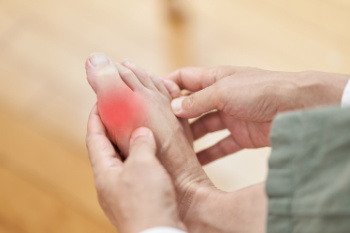 Gout and bunions are distinct foot conditions that can sometimes be confused due to similar symptoms of pain and swelling in the big toe area. Gout is a form of inflammatory arthritis caused by the accumulation of uric acid crystals in the joint, leading to sudden, severe pain, redness, and swelling. It often affects the big toe but can occur in other joints. Bunions are structural deformities where the big toe deviates toward the other toes, causing a bony bump on the side of the foot. This can result from wearing tight shoes, genetic factors, or arthritis. Bunions can cause chronic pain, especially while walking or wearing shoes, and can lead to swelling and redness. To manage gout, lifestyle changes such as reducing alcohol and purine-rich foods, staying hydrated, and taking medications to lower uric acid levels are recommended. Bunions may be managed with properly fitting shoes, orthotics, and, in severe cases, surgery. If you have toe pain, it is suggested that you schedule an appointment with a podiatrist for an accurate diagnosis and appropriate treatment plan for either condition.
Gout and bunions are distinct foot conditions that can sometimes be confused due to similar symptoms of pain and swelling in the big toe area. Gout is a form of inflammatory arthritis caused by the accumulation of uric acid crystals in the joint, leading to sudden, severe pain, redness, and swelling. It often affects the big toe but can occur in other joints. Bunions are structural deformities where the big toe deviates toward the other toes, causing a bony bump on the side of the foot. This can result from wearing tight shoes, genetic factors, or arthritis. Bunions can cause chronic pain, especially while walking or wearing shoes, and can lead to swelling and redness. To manage gout, lifestyle changes such as reducing alcohol and purine-rich foods, staying hydrated, and taking medications to lower uric acid levels are recommended. Bunions may be managed with properly fitting shoes, orthotics, and, in severe cases, surgery. If you have toe pain, it is suggested that you schedule an appointment with a podiatrist for an accurate diagnosis and appropriate treatment plan for either condition.
Gout is a painful condition that can be treated. If you are seeking treatment, contact one of our podiatrists from Lakewood Family Foot and Ankle. Our doctors will treat your foot and ankle needs.
What Is Gout?
Gout is a form of arthritis that is characterized by sudden, severe attacks of pain, redness, and tenderness in the joints. The condition usually affects the joint at the base of the big toe. A gout attack can occur at any random time, such as the middle of the night while you are asleep.
Symptoms
- Intense Joint Pain - Usually around the large joint of your big toe, and it most severe within the first four to twelve hours
- Lingering Discomfort - Joint discomfort may last from a few days to a few weeks
- Inflammation and Redness -Affected joints may become swollen, tender, warm and red
- Limited Range of Motion - May experience a decrease in joint mobility
Risk Factors
- Genetics - If family members have gout, you’re more likely to have it
- Medications - Diuretic medications can raise uric acid levels
- Gender/Age - Gout is more common in men until the age of 60. It is believed that estrogen protects women until that point
- Diet - Eating red meat and shellfish increases your risk
- Alcohol - Having more than two alcoholic drinks per day increases your risk
- Obesity - Obese people are at a higher risk for gout
Prior to visiting your podiatrist to receive treatment for gout, there are a few things you should do beforehand. If you have gout you should write down your symptoms--including when they started and how often you experience them, important medical information you may have, and any questions you may have. Writing down these three things will help your podiatrist in assessing your specific situation so that he or she may provide the best route of treatment for you.
If you have any questions, please feel free to contact our office located in Lakewood, CA . We offer the newest diagnostic and treatment technologies for all your foot care needs.
